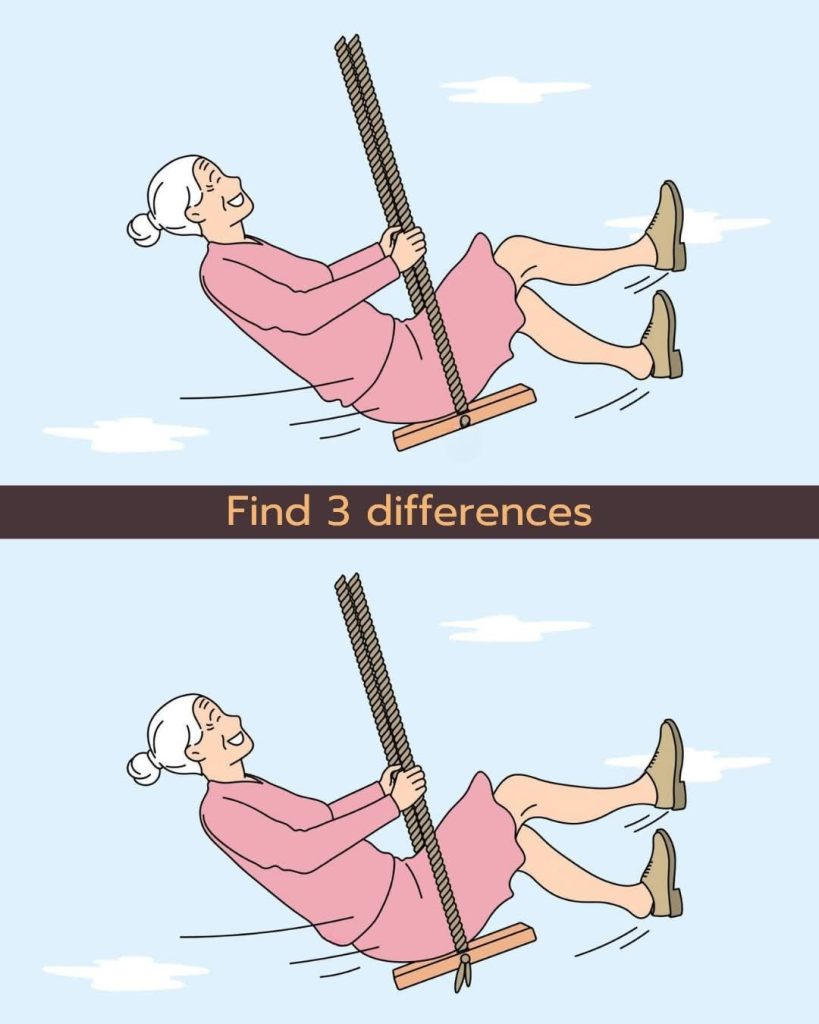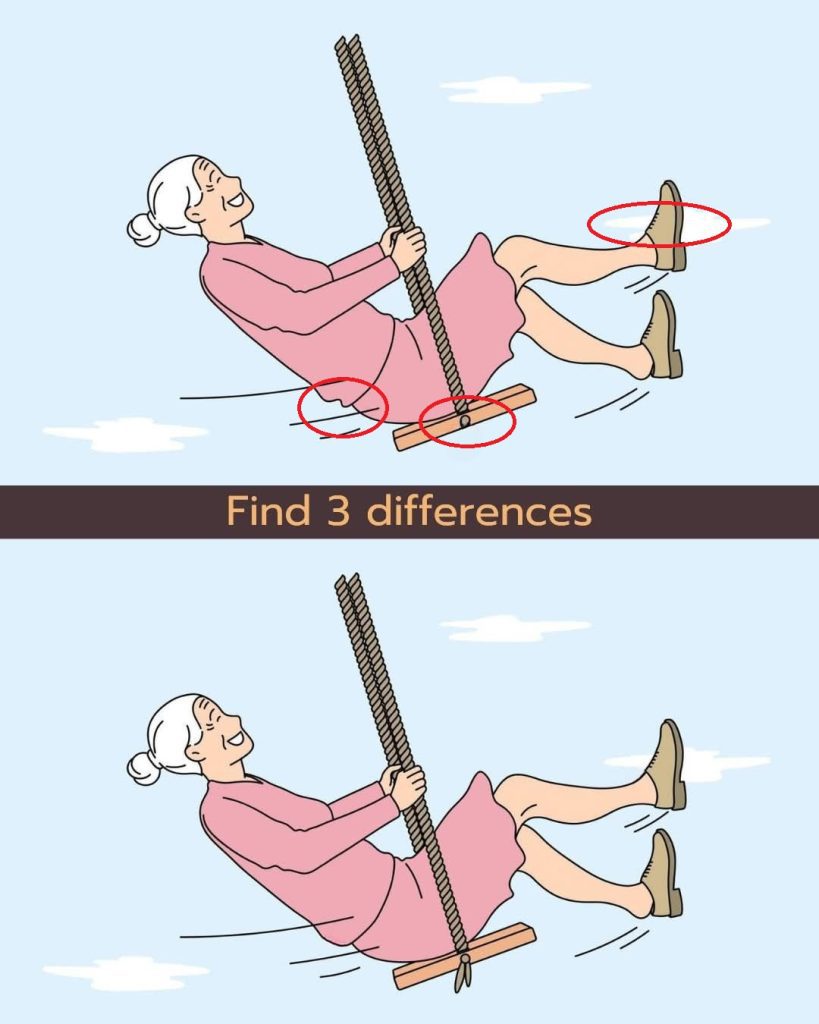In a fast-paced digital world where attention spans are shrinking and multitasking is the norm, truly looking—not just glancing—has become a lost art. That’s what makes visual puzzles like “Spot the Difference” so valuable. They seem simple, even childlike, but underneath their colorful exteriors lie tests of focus, precision, and patience. Today’s puzzle, featuring a joyful grandma on a swing, invites you to slow down and sharpen your vision. Hidden within the charm of the illustration are three subtle changes that challenge your perception and attention to detail.

At first glance, the images look identical. But with closer inspection, you’ll begin to see: this isn’t about what’s obvious. It’s about what’s hiding in plain sight.
The Illusion of Sameness
When we first look at the two images side by side, our brains immediately tell us, “These are the same.” That’s natural. We’re wired to recognize patterns and fill in gaps with assumptions. If two scenes are 95% similar, our minds tend to smooth over the rest.
But once you commit to looking deeper—breaking down the image into parts—you realize that the illusion of sameness is just that: an illusion. The changes are there. You just have to learn to see differently.
Video: Spot 3 differences!! #238
How to Approach a Puzzle Like This
Experienced puzzle-solvers don’t scan randomly. They divide the image into zones:
- The central character (in this case, the grandma and the swing)
- The background (sky, clouds, space around the figure)
- The details in motion (clothing folds, posture, ropes, accessories)
This method helps avoid getting overwhelmed by the whole image and instead allows for methodical comparison, section by section.
Now let’s break down the three key differences that emerge.
🔧 1. The Missing Bolt on the Swing
This is a clever one—right at the center. In the top image, the wooden swing has a small black bolt or pin in the center, where the two ropes are attached. It adds realism, structure, and visual balance to the swing.
In the bottom image, this bolt is missing. The ropes still appear attached, but the anchor point no longer exists visually.
What does this teach us? That even in the middle of the frame—the area we think we’ve already “seen”—we can miss things when they seem too ordinary. This tiny mechanical difference is a test of whether you’re paying attention to the connections, not just the characters.
✅ Difference #1: The bolt in the center of the swing is missing in the bottom image.
☁️ 2. The Cloud Behind the Right Foot Has Changed Shape
Here’s where things get tricky. Both images include a cloud near the grandma’s lifted right foot. But if you compare them carefully, you’ll see that the shape of the cloud is different.
- In the top image, the cloud is round and compact, resembling a small puff.
- In the bottom image, the cloud becomes longer and more stretched, almost like a smear.
This is a brilliant example of a deceptive constant: something that looks like it hasn’t changed, because it’s still “there.” But when you analyze its form, you see the subtle shift.
This plays with your expectation—your brain sees a cloud and assumes it’s the same cloud. But this difference proves the importance of not just seeing presence, but seeing how something appears.
✅ Difference #2: The cloud behind her foot is short and round in the top image, but long and flat in the bottom one.

👗 3. A Fold in Her Dress Is Missing
Finally, let’s look at the dress. In the top image, near her left hip (on the viewer’s right), there’s a subtle fold in the fabric, suggesting movement as the swing pushes forward. It gives the drawing life—motion captured in a still frame.
In the bottom image, that same fold is gone. The fabric looks flatter, more still, less animated.
This difference plays on texture and realism. It’s not about adding or removing objects. It’s about removing energy. A single crease can suggest action; its absence can change the entire tone of the pose.
✅ Difference #3: A small dress fold on her hip is missing in the bottom image.
Video: Find 3 differences! #611
Why These Differences Matter
You might be asking: why does this even matter? What’s the value in spotting a bolt, a cloud shape, or a fabric crease?
Because it’s not just about the puzzle. It’s about what the puzzle reveals.
Spot-the-difference challenges improve:
- Visual memory
- Pattern recognition
- Spatial awareness
- Patience and sustained attention
- The ability to detect subtle inconsistencies—a critical skill in everything from editing to engineering
In daily life, you’ll often need to catch what others overlook. A typo in a contract. A strange bump in the road. A change in someone’s tone. These tiny clues often lead to big discoveries.
A Puzzle That Trains Your Mind
This isn’t just entertainment—it’s brain training. The “Swinging Grandma” puzzle invites you to slow down, look twice, and question what you think you’ve already seen.
In a world obsessed with speed, it dares you to pause.
In a culture that values productivity, it rewards observation.
And in a time when people scroll endlessly, it invites you to study what’s right in front of you.
So—did you find all three differences on your own? If so, great job. If not, don’t worry. You’ve just given your brain a much-needed workout. And the next time you encounter one of these visual riddles, you’ll be sharper, steadier, and maybe even a little more curious.
Because sometimes, the things that look the same… aren’t.